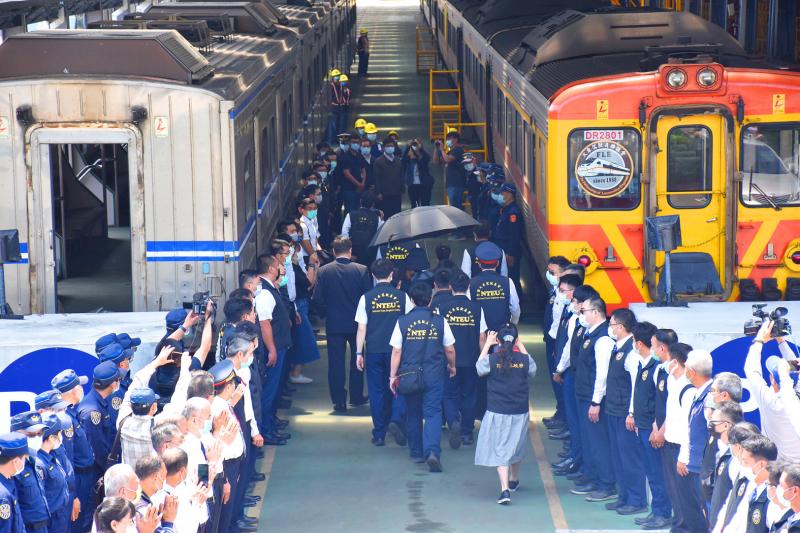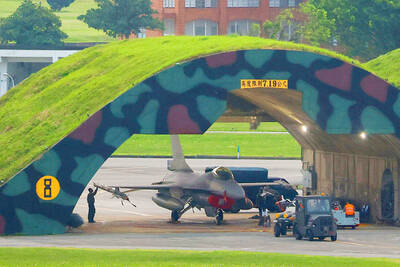The crane truck that caused last week’s fatal train accident had slid onto the tracks about one-and-a-half minutes before it was struck, the Taiwan Transportation Safety Board said yesterday.
The board had launched an investigation into the derailment, which killed 50 people and injured 211 people, making it the nation’s most devastating railway accident in decades.
Carrying 494 passengers and four Taiwan Railways Administration personnel, the southbound express train to Taitung hit the truck as it was about to enter the Cingshuei Tunnel (清水隧道) in Hualien’s Sioulin Township (秀林).

Photo: CNA
The train derailed following the collision, with the left side of the eighth carriage completely destroyed. The seventh carriage was severely deformed and detached from the sixth carriage, the board said.
The fourth, fifth and sixth carriages were twisted as well, it said.
Board investigators tried to reconstruct the accident from data retrieved from the train’s dashcam, an onboard automatic train protection system, train control management system, a vehicle data recorder (VDR) on the crane truck, and footage from surveillance cameras along a nearby highway and other data, board chairman Young Hong-tsu (楊宏智) said.
The crane truck entered the construction site at 8:49am on Friday, carrying a load of used tires, an investigation report said.
VDR data showed that there were other vehicles operating on site, including excavators and motorcycles, the board’s Rail Occurrence Investigation Division convener Li Gang (李綱) said.
The Taiwan Railways Administration said that it had informed contractors that they had to stop all construction work during the Tomb Sweeping Day long weekend.
The board also traced the movement of the crane truck from the VDR data, which showed that it slid down from the top of a slope and was stuck in the bushes when it hit a curve.
The VDR on the truck stopped recording after the truck’s engine was turned off, Li said.
“Based on footage from surveillance cameras and our on-site observation, we infer that the truck fell downhill through a treeless patch on the side of the slope after the engine was turned off and fell on the railroad, with the front of the truck facing the Heren Tunnel (和仁隧道), from which the Taroko Express emerged. A head-on collision ensued about one-and-a-half minutes after the truck flipped over onto the tracks,” Young said.
Asked if the driver left the truck after the engine was turned off, Young said that such information would be disclosed at the discretion of prosecutors.
Dashcam footage from the train showed that the driver could see the truck when the train emerged from the Heren Tunnel.
The train was traveling at 125kph, which means it would have needed 500m to 600m to come to a full stop.
The truck was about 240m from the Heren Tunnel, Young said.
Data from the train control management system showed the train driver and his assistant trying to stop the train by applying the brakes, but they only managed to slow it to 121kph.
The board found that the truck’s brake system was modified as well, Li said.
The board has disclosed about 70 to 80 percent of the evidence gathered on site during the holiday, Young said, adding that it would publish a complete report within four months.

MISINFORMATION: The generated content tends to adopt China’s official stance, such as ‘Taiwan is currently governed by the Chinese central government,’ the NSB said Five China-developed artificial intelligence (AI) language models exhibit cybersecurity risks and content biases, an inspection conducted by the National Security Bureau (NSB) showed. The five AI tools are: DeepSeek, Doubao (豆包), Yiyan (文心一言), Tongyi (通義千問) and Yuanbao (騰訊元寶), the bureau said, advising people to remain vigilant to protect personal data privacy and corporate business secrets. The NSB said it, in accordance with the National Intelligence Services Act (國家情報工作法), has reviewed international cybersecurity reports and intelligence, and coordinated with the Ministry of Justice Investigation Bureau and the National Police Agency’s Criminal Investigation Bureau to conduct an inspection of China-made AI language

BOOST IN CONFIDENCE: The sale sends a clear message of support for Taiwan and dispels rumors that US President Donald Trump ‘sold out’ the nation, an expert said The US government on Thursday announced a possible sale to Taiwan of fighter jet parts, which was estimated to cost about US$330 million, in a move that an expert said “sends a clear message of support for Taiwan” amid fears that Washington might be wavering in its attitude toward Taipei. It was the first announcement of an arms sale to Taiwan since US President Donald Trump returned to the White House earlier this year. The proposed package includes non-standard components, spare and repair parts, consumables and accessories, as well repair and return support for the F-16, C-130 and Indigenous Defense Fighter aircraft,

CHECKING BOUNDARIES: China wants to disrupt solidarity among democracies and test their red lines, but it is instead pushing nations to become more united, an expert said The US Department of State on Friday expressed deep concern over a Chinese public security agency’s investigation into Legislator Puma Shen (沈伯洋) for “secession.” “China’s actions threaten free speech and erode norms that have underpinned the cross-strait ‘status quo’ for decades,” a US Department of State spokesperson said. The Chongqing Municipal Public Security Bureau late last month listed Shen as “wanted” and launched an investigation into alleged “secession-related” criminal activities, including his founding of the Kuma Academy, a civil defense organization that prepares people for an invasion by China. The spokesperson said that the US was “deeply concerned” about the bureau investigating Shen

LIMITS: While China increases military pressure on Taiwan and expands its use of cognitive warfare, it is unwilling to target tech supply chains, the report said US and Taiwan military officials have warned that the Chinese People’s Liberation Army (PLA) could implement a blockade within “a matter of hours” and need only “minimal conversion time” prior to an attack on Taiwan, a report released on Tuesday by the US Senate’s China Economic and Security Review Commission said. “While there is no indication that China is planning an imminent attack, the United States and its allies and partners can no longer assume that a Taiwan contingency is a distant possibility for which they would have ample time to prepare,” it said. The commission made the comments in its annual